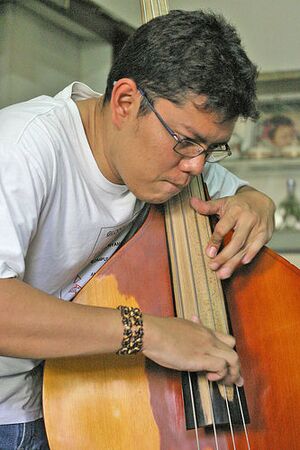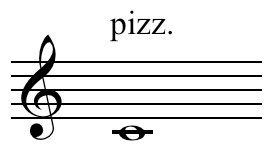Pizzicato facts for kids
Pizzicato (say "pit-sih-KAH-toh") is a way of playing string instruments by plucking the strings with your finger instead of using a bow. Think of it like strumming a guitar, but on an instrument usually played with a bow, like a violin, viola, cello, or double bass.
Composers use the word "pizzicato" (or just "pizz") in music when they want players to pluck the strings. When it's time to use the bow again, the music will say "arco." "Arco" is an Italian word meaning "bow."
Contents
How to Play Pizzicato Notes
When playing pizzicato on instruments like the violin, viola, or cello, musicians usually pluck the string with their index finger (pointing finger) of their right hand. They pluck the string over the fingerboard.
- Bass players often use both their index and middle fingers.
- Sometimes, players might rest their thumb on the edge of the fingerboard. This helps keep their hand steady.
- For very fast pizzicato parts, musicians might use more fingers.
- Cellists and double bass players can also use their thumb to pluck strings, especially when playing chords.
Left-Hand Pizzicato
It is also possible to play pizzicato with the left hand. This is the hand that usually presses down on the strings to change notes.
- Plucking an open string (a string not pressed down) with the left hand is not too hard.
- Plucking a "stopped" string (a string pressed down by a finger) is more difficult.
- The famous violinist and composer Niccolò Paganini wrote some very challenging pieces. These pieces included extremely difficult left-hand pizzicato parts.
Changing Between Bowing and Plucking
Musicians often need to switch quickly between bowing and plucking.
- It's easy to play a bowed note and then immediately pluck a note if the bowed note finished near the end of the bow held by the player.
- If the bowed note finishes near the tip of the bow, the player needs a moment to get their hand ready to pluck.
- Switching back to bowing can take a little more time. The player has to get the bow back into the correct playing position.
- If a piece has a long pizzicato section, it's more comfortable for the player to put the bow down. This is fine as long as there is enough time to pick the bow up again when the music goes back to "arco."
The Sound of Pizzicato
Pizzicato notes sound short and detached. This means they are played separately, not smoothly connected. Musicians can create different sounds by plucking the string in different places.
- High notes played pizzicato sound very short and dry.
- Pizzicato notes on the double bass sound much bigger and more resonant (they have a deep, booming sound).
- Double basses often play pizzicato to add rhythmic and harmonic support to the music. For example, in a waltz, cellos and violas might play the "um-cha-cha" accompaniment. The double basses might just pluck on the "um" (the first beat of the bar).
- Double basses usually play pizzicato when they perform with jazz groups.
Special Pizzicato Effects
One special effect is made by pulling the string hard and letting it go so it snaps against the fingerboard. This creates a sharp, percussive sound. The composer Béla Bartók used this effect several times in his music.
This "snap pizzicato" is different from "slap bass." Slap bass is a technique used by jazz bass players. They hit the strings at the end of a note to make a percussive sound.
Pizzicato in Music History
Composers started using pizzicato in orchestras as early as the 17th century.
- Claudio Monteverdi used pizzicato in his opera Il combattimento di Tancredi e Clorinda.
- In the 19th century, Romantic composers often asked for pizzicato.
- Pyotr Ilyich Tchaikovsky's Symphony No. 4 has an entire scherzo movement played only by pizzicato strings.
- Johann Strauss II wrote a famous piece called Pizzicato Polka.
- In the 20th century, Benjamin Britten wrote a whole movement for pizzicato strings in his Simple Symphony.
See also
 In Spanish: Pizzicato para niños
In Spanish: Pizzicato para niños



